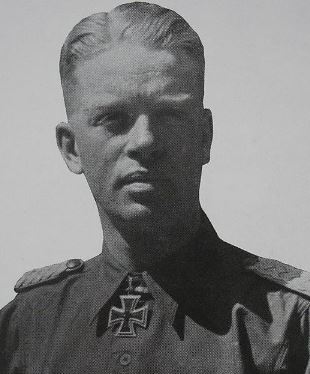Kesten, Dieter (Waffen SS)
- Date of birth:
- June 9th, 1914 (Gelsenkirchen-Rotthausen, North Rhine-Westphalia, Germany)
- Date of death:
- April 3rd, 1945 (Möllersdorf, Vienna/Lower Austria, Austria)
- Buried on:
- German War Cemetery Blumau
Plot: 3. Row: 1. Grave: 59. - Service number:
- SS-Nr.: 149.486 // NSDAP-Nr.: 4.198.299
- Nationality:
- German
Biography
SS-Sturmbannführer Dieter Fritz Paul Wilhelm Kesten
Promotions:
20.04.1937: SS-Untersturmführer
30.01.1939: SS-Obersturmführer
20.04.1941: SS-Hauptsturmführer der Waffen-SS - RDA 20.04.1940
20.04.1944: SS-Sturmbannführer der Waffen-SS
Career:
01.09.1933: joined the SS, serving in the SS-Standarte 7 then SS-Standarte 79
00.00.1935-00.04.1936: SS-Junkerschule Braunschweig
00.04.1936: SS-Ustuf, SS-Junkerschule Braunschweig
01.05.1937: joined the NSDAP
00.00.1937: SS-Ustuf, II. Bataillon, SS-Regiment 'Germania' then Ordonnanz-Offizier, Stab, SS-Regiment 'Germania', SS-VT
00.05.1940: SS-Ustuf, Adjutant, SS-Brigadeführer Fritz Herrmann, the future commander of SS-Division 'Nord'
00.12.1940: SS-Ustuf, Adjutant, Kdr, commander of the Waffen-SS 'Ost'
00.05.1941: SS-Ustuf, Adjutant, SS-Kampfgruppe 'Nord'
00.05.1942: SS-Ustuf, Adjutant, SS-Division 'Das Reich'
00.00.1942: Führer, 1. Kompanie, SS-Regiment 'Langemarck', 27. SS-Freiwilligen-Division 'Langemarck' then divisional adjutant
00.00.1943-00.11.1943: Führer, 6. Schwadron, SS-Panzer-Regiment 2, 2. SS-Panzer-Division 'Das Reich' - battle of Kursk, Mius River, Kharkov
22.07.1943: fightings near Starja-Ljubotin and Kommuna - 53 Soviet tanks destroyed
23.07.1943: fightings 12km West of Kharkov - 7 Soviet tanks destroyed
24.07.1943: fightings between Udy-Bogens and Orkan, south west of Kharkov - 60 T-34 destroyed - Kesten's panzers knocked out 29 of the 60 tanks
00.11.1943: Kdr, II. Abteilung, SS-Panzer-Regiment 2, 2. SS-Panzer-Division 'Das Reich'
03.04.1945: KIA near Möllersdorf, south of Vienna
Do you have more information about this person? Inform us!
- Period:
- Second World War (1939-1945)
- Awarded on:
- November 10th, 1939
- Period:
- Second World War (1939-1945)
- Awarded on:
- 1941
- Period:
- Second World War (1939-1945)
- Awarded on:
- April 20th, 1942
- Period:
- Second World War (1939-1945)
- Awarded on:
- August 1st, 1942
- Period:
- Second World War (1939-1945)
- Period:
- Second World War (1939-1945)
- Period:
- Second World War (1939-1945)
- Awarded on:
- July 13th, 1943
- Period:
- Second World War (1939-1945)
- Rank:
- SS-Hauptsturmführer der Reserve (Captain of Reserves)
- Unit:
- Führer, 6. Schwadron, SS-Panzer-Regiment 2, 2. SS-Panzer-Division "Das Reich", 4. Panzerarmee, Heeresgruppe Süd
- Awarded on:
- November 12th, 1943
Submitted on November 3rd 1943.
Preliminary document and decoratioon on November 17th 1943 to Pz.AOK 4.
- Period:
- Second World War (1939-1945)
Sources
- Photo 1:
- - MOONEY, PETER, Waffen-SS Knights and their Battles, Schiffer Publishing, Ltd., 2012.
- Federl, C., Die Ritterkreuzträger der Deutschen Panzerdivisionen 1939-1945, VDM Heinz Nickel, Zweibrücken, Germany, 2000
- Fellgiebel W.P., Elite of the Third Reich, The recipients of the Knight's Cross of the Iron Cross 1939-1945: A Reference, Helion & Company Limited, Solihull, 2003, ISBN 1-874622-46-9
- Die Träger des Ritterkreuzes des Eisernen Kreuzes 1939-1945


















